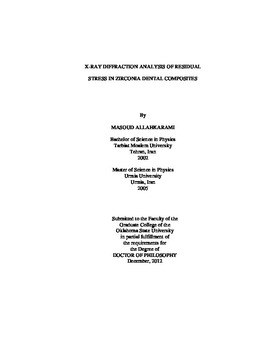| dc.contributor.advisor | Hanan, Jay C. | |
| dc.contributor.author | Allahkarami, Masoud | |
| dc.date.accessioned | 2015-06-17T20:04:30Z | |
| dc.date.available | 2015-06-17T20:04:30Z | |
| dc.date.issued | 2012-12 | |
| dc.identifier.uri | https://hdl.handle.net/11244/14691 | |
| dc.description.abstract | Dental restoration ceramic is a complex system to be characterized. Beside its essential biocompatibility, and pleasant appearance, it requires being mechanically strong in a catastrophic loading environment. Any design is restricted with geometry boundary and material property limits. Inspired by natural teeth, a multilayer ceramic is a smart way of achieving an enhanced restoration. Bi-layers of zirconia core covered by porcelain are known as one of the best multilayer restorations. Residual stresses may be introduced into a bi-layer dental ceramic restoration during its entire manufacturing process due to thermal expansion and elastic property mismatch. It is impossible to achieve a free of residual stresses bi-layer zirconia-porcelain restoration. The idea is to take the advantage of residual stress in design in such a way to prevent the crack initiation and progression. The hypothesis is a compressive residual stress at external contact surface would be enabling the restoration to endure a greater tensile stress. Optimizing the layers thickness, manufacturing process, and validating 3D simulations require development of new techniques of thickness, residual stresses and phase transformation measurement. In the present work, a combined mirco-tomography and finite element based method were adapted for thickness measurement. Two new 2D X-ray diffraction based techniques were adapted for phase transformation area mapping and combined phase transformation and residual stress measurement. Concerning the complex geometry of crown, an efficient method for X-ray diffraction data collection mapping on a given curved surface was developed. Finally a novel method for 3D dimensional x-ray diffraction data collection and visualization were introduced. | |
| dc.format | application/pdf | |
| dc.language | en_US | |
| dc.rights | Copyright is held by the author who has granted the Oklahoma State University Library the non-exclusive right to share this material in its institutional repository. Contact Digital Library Services at lib-dls@okstate.edu or 405-744-9161 for the permission policy on the use, reproduction or distribution of this material. | |
| dc.title | X-ray diffraction analysis of residual stress in zirconia dental composites | |
| dc.contributor.committeeMember | Sallam, Khaled A. | |
| dc.contributor.committeeMember | Ley, Tyler | |
| dc.contributor.committeeMember | Singh, Raman P. | |
| osu.filename | Allahkarami_okstate_0664D_12518.pdf | |
| osu.accesstype | Open Access | |
| dc.type.genre | Dissertation | |
| dc.type.material | Text | |
| dc.subject.keywords | dental composites | |
| dc.subject.keywords | micro tomography | |
| dc.subject.keywords | phase transformation | |
| dc.subject.keywords | residual stress | |
| dc.subject.keywords | x-ray diffraction | |
| dc.subject.keywords | zirconia | |
| thesis.degree.discipline | Mechanical Engineering | |
| thesis.degree.grantor | Oklahoma State University | |
